

Swamp Rat Spotters Guide, Part 3
Welcome to the third and final installment of my Swamp Rat Spotter's Guide, a thumbnail look at "Big Daddy" Don Garlits’ historic hot rods of the last six decades. Inspired by my recent reading of his new book, Don Garlits and His Cars, which is filled with tales of how these incredible machines were born, lived, and sometimes died, I decided that a crib sheet would be an invaluable resource to me, so I've spent the better part of the last 10 days and two columns sorting through them all, digging up anecdotes and photos to tell the story of the Swamp Rat lineage.
As I mentioned in the first installment last week, although this list will end at No. 34, there have been a lot more than 34 Swamp Rats. My final count, including all of the A, B, and sometimes C editions, is 46. Today, I present the final 15, beginning with Swamp Rat 21 and ending with SR 34.
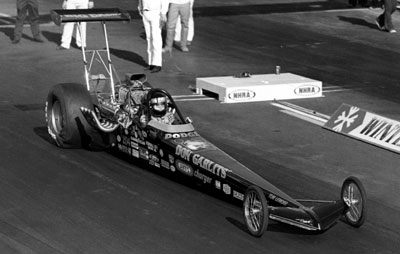 |
Swamp Rat 21 (1975): Believe it or not, kids, Funny Car legend "Jungle Jim" Liberman once wanted to drive in Top Fuel, so, naturally, he went to Garlits for a chassis. In the fall of 1974, Garlits and Gary Werner built what has become known as "the Jungle car" for Liberman to campaign in 1975, but Liberman quickly found out that track promoters wanted the Funny Car wild man and not the dragster guy, so he canceled his order. Richard Holcomb had just bought Swamp Rat 20-B from beneath Garlits before he could ever drive it, so Garlits, needing a car, took Liberman's. Because the car was built to accommodate the bigger Liberman, it didn’t fit Garlits very well, so extra seat padding was added. The car won the 1975 Winternationals — after Don Ewald famously crossed the centerline in round one against an up-in-smoke Garlits — but was retired at midseason. The car was sold in 1976 to England's Santa Pod Raceway, and Garlits set the British speed record in the car the next year at 232 mph; in gratitude for his appearance, the track gave him the car back for his newly created museum.
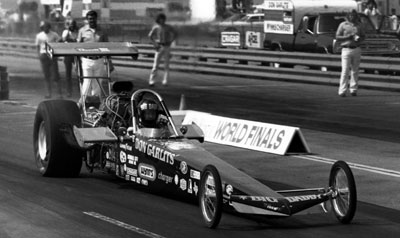 |
Swamp Rat 22 (1975): The car that succeeded SR 21 would go into the record books in a "big" way and stay there for years: This is the car in which Garlits brought the class to its knees with a 5.63-second clocking at the World Finals, a record that stood for more than six years. Built by Garlits, “T.C.” Lemons, and Don Cook on a 240-inch wheelbase, the car was lightweight and fast from the first go. By year's end, Garlits was locked in a tight points battle with Gary Beck that grew ugly off the racetrack, too, because both were reportedly under contract to attend every IHRA national event. The NHRA Fallnationals in Seattle happened to be on the same weekend as the IHRA World Finals, and Beck opted to run the Seattle event to boost his NHRA bid. Lawsuits were threatened but never came to fruition, and the duo entered the NHRA World Finals at Ontario Motor Speedway with Beck holding a 400-point lead. Knowing Ontario's reputation for quick runs and realizing that he'd probably need national record points to pass Beck, Garlits came well-prepared. He had hoarded oversize Goodyear slicks, built a new engine, and even lengthened the chassis by 10 inches, and it all paid off with that monstrous 5.63 that helped him win the event and the championship and was attached to the sport's first official 250-mph run. The historic car was retired at year's end and has never left Garlits' possession other than for occasional displays; it was hauled out of mothballs to run at — and win — the 1977 Gatornationals.
Swamp Rat 23 (1976-77): This is another oddball in the series because it was not from the Garlits factory. Werner had left the chassis operation, so Garlits commissioned Glen Blakely (who had built SR 20-A, aka the Harrah's car) to build "Big Daddy's" next car, which won the IHRA championship with Ron Barrow as crew chief. Garlits was steamed with NHRA about the Beck issue and took a $100,000 contract from IHRA President Larry Carrier to not only run all 10 IHRA events, but also not to run any NHRA events. In late 1976, this car was switched from Keith Black power to Donovan 417, then set low e.t. of the 1977 NHRA Winternationals, where it also was runner-up. Garlits was runner-up in Bakersfield, too, but was going through Donovan parts like water and had to pull out SR 22 to win in Gainesville. The car ended up on display at the International Motorsports Hall of Fame in Talladega, Ala., for a decade and most recently was sent to George Schreiber's museum near Branson, Mo.
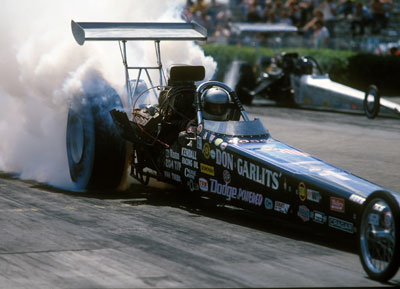 |
Swamp Rat 24 (1977-79): Purpose-built by Garlits and Cook in mid-1977 to accommodate the Donovan engine, this car began life as a two-piece bolt-together chassis — ostensibly to aid in maintenance — but the car broke in the trailer after the first test session, so it became a one-piece car. Wynn's and Garlits had parted company — Garlits says that it was so that it could sponsor Don Prudhomme and Tom McEwen — and the U.S. Navy stepped in with a $50,000 sponsorship. For only the third or fourth time, Garlits painted his race car something other than black, spraying this one blue and white at the request of the Navy, but Garlits' last-minute addition of a cross to the cowl, accompanied by the words "God is Love," scotched the deal after Garlits refused to remove it. For the first time in years, Garlits’ car ran lettered only with his name. Herb Parks had come onboard as the new crew chief, replacing Barrow, who went to drive for Neil Mahr, and Lemons, who retired. Parks, like Lemons before him, would become Garlits' longtime sidekick and be there for many of Garlits' great moments. They opened the season with low e.t. at the NHRA Winternationals, won the IHRA Winternationals and the NHRA Gatornationals, and later in the year converted the car to run the KB block again. This car got two new back halves and a 24-inch extension during its rough-and-tumble two seasons and now rests peacefully in the Garlits museum.
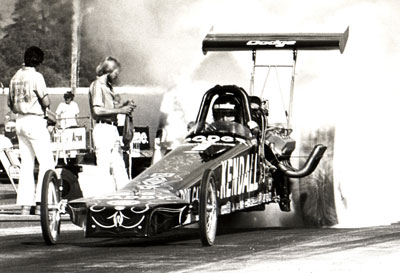 |
Swamp Rat 25 (1980): "The car that never should have been built," Garlits exclaimed of this thick-nosed car, an attempt at ground effects that he says went bad from the start when he hired Lester Guillory to build it but saw little progress. He didn't know it at the time that he took the partially completed car home to Florida in a huff to complete it himself, but Guillory was dying of kidney failure. Garlits and Parks finished the car — sans any aero trickery — and had Larry Sikora skin it. Garlits had Mello Yello signed up to sponsor him in 1980, but when asked not to put the cross on the car as he had on SR 24, Garlits again refused to bow to sponsor pressure, which again cost him the deal. The cross stayed, the sponsorship left. Fortunately for Garlits, Larry Woods of Kendall — then a relatively minor ($6,000) sponsor — seized the moment and offered to sponsor Garlits for $75,000, and he could keep the cross. This began "Big Daddy's" long association with the motor-oil company, and he was happy to paint the company’s name in foot-high letters on his car's flanks. The car — dubbed Godzilla by Garlits and Parks — was too stiff and failed to qualify in its debut in Pomona, and Garlits was too ashamed to face the fans Sunday and pulled out. He and Parks took a saw to parts of the frame but went a bit overboard, causing it to sag. Garlits went to a hardware store and bought some turnbuckles and a roll of eighth-inch stainless-steel cable, which they strung from front to back and tightened until they liked what they saw. The car thus became known affectionately to them as the Kendall Kable Kar. The car still never ran well and was retired early to the museum.
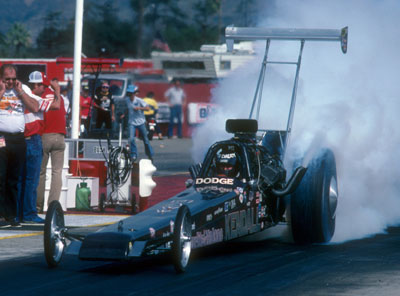 |
Swamp Rat 26 (1980-84): Godzilla's replacement was ready by October, but Garlits wasn't, opting to sit out the 1981 NHRA season in protest of several rule changes, most notably the self-starting and mandatory reverser rules. Swamp Rat 26 was "lean and light" — Garlits forsook paint for black anodized panels with stick-on lettering — and with the power that Garlits and Parks had learned to make to get the porky Godzilla car down the track, they seemed to be ahead of the game. The car was completed in time to run the Florida Winter Series events, but Parks quit that winter after the tough 1980 season, and Garlits won just two AHRA events in 1981. Shirley Muldowney beat him for the AHRA championship to boot, no doubt one of Garlits' career-worst years on the AHRA trail that he so regularly dominated. Garlits ran infrequently in the next three seasons, and Swamp Rat 26 might have just gone quietly into retirement as a disappointment had old pal Art Malone not called Garlits in the summer of 1984 and offered to fund a run at the 1984 Indy title. Malone got Garlits new parts, and they coaxed Parks out of retirement, and despite an aging car and a team of "dinosaurs" (Garlits' word), they won the race, completing a storybook comeback straight out of Hollywood. Garlits went on to also win a big eight-car Top Fuel show at Firebird Int'l Raceway and the NHRA World Finals — "Big Daddy" was back!
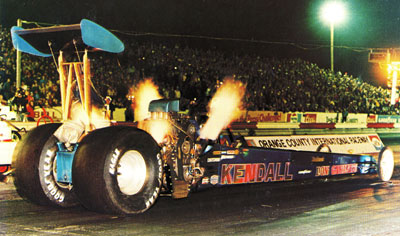 |
Swamp Rat 27 (1982): Although he wasn’t attending many national events, Garlits was still running some match races and still trying to innovate, and few of his ideas were wilder than this one, the infamous Garlits sidewinder. Chuck and Mike Sage, who owned a gear manufacturing company in Ohio that built gear sets for tractor pullers and other applications, had dabbled with a sidewinder Top Alcohol Dragster and approached Garlits about a fuel car. Garlits liked the idea of a car that wouldn’t torque to one side on the launch, so he had the Sage brothers build the chassis in their shop to accommodate the transverse-mounted Hemi, which connected to the rear end through a complex set of gears. The gears proved to be a true weak link initially, but once they built a beefy-enough unit, the problem became the severe power loss sucked up by the gear set, which Garlits estimated to be about 21 percent, compared to 7 percent in a conventional setup. Garlits handed the car back to Mike Sage, who continued to experiment with the configuration on alcohol but with little success, and Sage eventually brought the car back to Garlits to display in the museum.
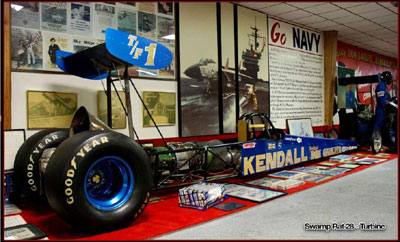 |
Swamp Rat 28-A (1983): Garlits was about five years too soon in the return to high-gear-only in Top Fuel, and the clutches weren't there to help him control such a setup; however, he still had some success in that configuration with this car, which, like the sidewinder, had weight-saving anodized blue body panels. The car was built short — just 220 inches, and, without a transmission to get in the way, the engine was set way back — and with superthin tubing, again to save weight. Severe tire shake damaged the chassis in just its second outing, forcing Garlits to sideline the car.
Inspired by the T-85 jet turbine helicopter engine that former drag racer Craig Arfons was using in tractor pulling, Garlits backhalved 28-A to accommodate a turbine, which was legal in AHRA Top Fuel competition at the time (NHRA had outlawed the use of nonautomotive engines in 1961). The car weighed less than 1,000 pounds, and with 2,100 horsepower on tap, it seemed to be a winning recipe, but the duo found the right gearing to be elusive as the engine lacked torque and demanded to be run at high rpm. Even worse, the engine was too quiet for Top Fuel, and the fans hated it, even after Arfons and Garlits rigged a flame-throwing afterburner to the engine. Garlits used the car for another promotional poster for the Navy, taking it aboard the aircraft carrier John F. Kennedy (as he had done with Swamp Rat 16 to Lexington in 1972). The car also is in the Garlits museum.
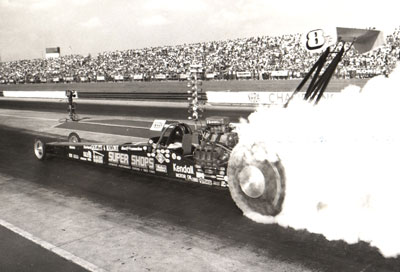 |
Swamp Rat 29 (1985): Buoyed by his success at the end of 1984 with aging Swamp Rat 26, Garlits built a new Rat for an assault on the 1985 NHRA world championship. Parks was back in the fold permanently, and together they built this car, which enjoyed backing from Super Shops and In-N-Out Burger. The car crashed on one of its first runs, in a January match race against old nemesis Beck at Firebird Int'l Raceway, when the wing struts buckled but was repaired at Johnny West's local shop and made its official debut at the NHRA Winternationals to kick off what indeed would be a championship season, Garlits' first on the NHRA tour since 1975. The car was fronthalved upon its return to Florida and won six NHRA races and set the new national speed record at 268 mph, fueling Garlits' desire to be the first to eclipse 270 mph.
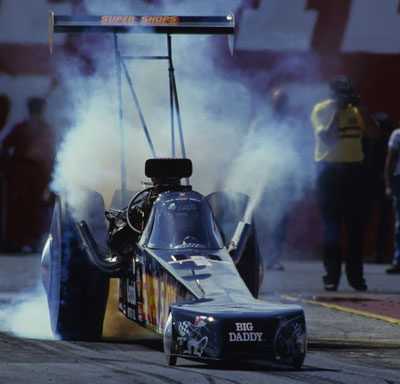 |
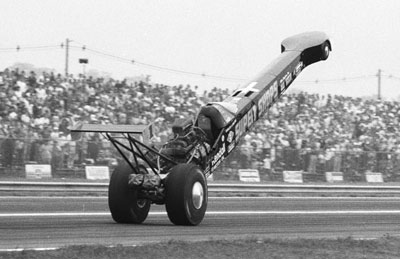 |
Swamp Rat XXX (1986-87): In the pantheon of famous Garlits cars — iconic machines such as Swamp Rat I, Swamp Rat V, Swamp Rat VI-B, and Swamp Rat 22 — this cockpit-canopied streamliner may well be at the top of the pyramid. Garlits says that the inspiration for the car's covered nose came from watching dragsters race through the post-oildown remnants of oil absorber and noting that the rotating front tires were kicking up the rice-hull ash 30 feet in front of the car, something that the Funny Cars didn't do. Garlits had Mike Magiera fabricate the nosepiece and constructed front "tires" out of 13-inch aluminum discs wrapped with industrial fan belts to fit beneath it. The belts would exit the wheels after almost every run, but that didn’t stop the “Rat Under Glass” from running 272.56 mph in the car's winning debut in Gainesville in 1986. Garlits later abandoned those wheels to run small-airplane tires that worked well but, ironically, took flight in his famous July 12 blowover wheelstand at the NHRA Summernationals. Garlits says that he was held up an extra minute on the starting line while Parks tried to stop a small fuel leak and that the combination of more heat in the engine and less fuel in the tank contributed to the backflip. The car was badly damaged (who could forget Garlits' classic TV interview, when he told Steve Evans that the car couldn’t run anymore at that race? "Even I'm not that crazy," he said in a good-natured nod to those who still viewed him as a bit unconventional, on and off the track) and had to be backhalved in the Florida shop to complete the season, which ended again with Garlits atop the points standings. Swamp Rat XXX also ran about half of the 1987 campaign and then famously became part of a display at the Smithsonian Institution the following year.
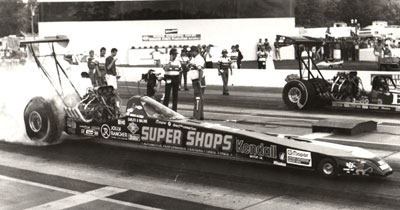 |
Swamp Rat 31 (1987): The follow-up streamliner, built by Garlits and Mark Buchanan, debuted at the NHRA event in Brainerd in August 1987 but didn't live long. The next weekend, at an AHRA event in Spokane, Wash., with a new Magiera-built triple-element wing on the back, the front end again soared skyward and over. Unlike the Englishtown blowover, in which Garlits had serendipitously landed back on all four wheels, Swamp Rat 31 tumbled hard upon return to terra firma and was pretty much destroyed. Garlits didn’t fare much better, suffering a crushed vertebra and several broken ribs. The car was beyond repair but went on display as-was for several years in a World of Wheels display before being returned to Garlits' museum, where it sits in its post-wreck condition.
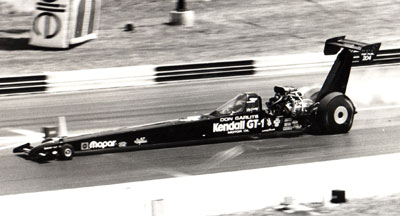 |
Swamp Rat 32 (1992): Garlits didn’t race for years after the Spokane wreck, immersing himself in his museum as well as television work for Diamond P, though he did memorably test-drive Muldowney's car in Dallas in 1989 when he was working with her team as a consultant (something none of us thought we'd ever see!). Garlits became interested again in 1991 and commissioned Murf McKinney to design a new car that again would break the Top Fuel mold that he dubbed the NFR (In the book, he says that stood for "No Funny Rules," which is the cleaned-up version of what the F really stood for). As proposed, the car would be a three-wheeler with a single front wheel that also sported a rudder so that the car would be steerable with the front end off the ground. To combat the growing issue of rear-wing-strut failure, the duo opted for a single center-mount post, sheathed in aerodynamics, which Garlits dubbed the “monowing." In the interest of being able to compete with the car (i.e., having a car that was within the rules), the single front tire and planned movable wing were abandoned, but the monowing stayed and finally was blessed by NHRA. The car, like its predecessors, had a cockpit canopy and small front tires but no nosepiece. It debuted at the NHRA Atlanta race in 1992 and didn't qualify, and, worse yet, Garlits had suffered a detached retina in his right eye in a two-parachute stop during testing and had to leave the cockpit again. Former Funny Car driver Bruce Larson took over the driving duties for the rest of the year and ran as fast as 299 mph with the car.
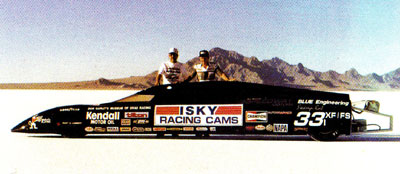 |
Swamp Rat 33 (1988): Another SR anomaly, this car, dubbed the Saltliner, was never intended for the dragstrip but for the Bonneville Salt Flats and a record attempt against the FX/GS mark. Built by Jim Schuman in his Blue Engineering shop in downtown Lincoln, Neb., guided by project manager Rich Venza, and powered by a supercharged flathead engine, the car easily carried Garlits — who, remarkably in his amazing career, had never been to the Salt Flats — to membership in the famed 200-mph Club and a new record of 217.947 mph in August 1988. Although the team planned later to put a 300-cid Chrysler Hemi in the car for other record attempts, that never happened, and Venza ran the car a few more times in its current configuration before giving the car to Garlits to display at the museum. It's not clear why this 1988 car is labeled 33 when it actually ran more than three years before 32, but perhaps the project had been on the board that long. Garlits doesn’t say.
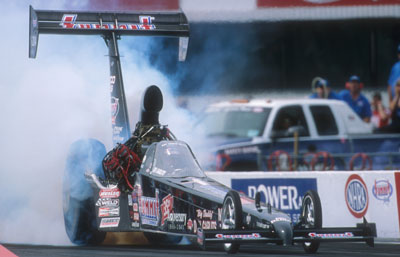 |
Swamp Rat 34 (1993-94, 2002-03): The final car in the long and famous line of Swamp Rats again was built by McKinney and incorporated all of the knowledge gained from SR 33, which included lowering the cockpit for better airflow to the injector. Larson drove the car again for two seasons but had no luck on the NHRA trail. At the end of the 1994 season, Garlits loaned the car to former Funny Car and fuel altered pilot Richard Langson (but sold him the equipment to run it … spare parts, tools, and transporter) and served as his crew chief in 1995, albeit with little success again. Langson returned the car to Garlits, who put it in storage. In 1999, after surgery to his eyes, Garlits was given the green light to return to the cockpit and drove one of Paul Smith's cars in a Florida match race against Muldowney Dec. 31, 1999, to ring in the new millennium.
Garlits thought that his résumé still was lacking one thing — a four-second, 300-mph time slip — so he pulled SR 34 out of storage and with a collection of old friends, including Tim and Rick Bucher, the sons of the late Top Fuel racer Jim Bucher, began preparing the car to run at the 2001 U.S. Nationals during NHRA's 50th Anniversary season. As the car was nearing completion, Garlits was informed by NHRA that the 8-year-old car did not meet safety specifications and outlined the necessary changes. With time running short, the list was too long and complex, and the project ground to an abrupt and heart-wrenching halt. The story didn’t end there, though: Gary Clapshaw loaned Garlits his car, which carried "Big Daddy" to a satisfying 4.72 at 303.37 mph, which qualified him for the show. He lost in round one to Mike Dunn, but the battle already had been won.
Garlits brought the car up to spec and competed at the 2002 Gatornationals and U.S. Nationals, and even old pal Lemons was part of the crew. Garlits ran a career-best speed of 318.54 mph but was bumped out of the show in the final session, the only time that he had ever failed to qualify at the Big Go. Garlits upped his speed mark to 323.04 at the 2003 Gatornationals and, with backing from Summit Racing Equipment, competed in Atlanta, Columbus, and Indy, where he again missed the field despite a 4.77 e.t. Garlits and Summit had planned to carry their effort into 2004, but at the insistence of his wife, Pat, he retired.
Garlits, of course, is still very visible on the dragstrip with his Dodge Challenger Drag Pak Stocker (which, like the other door cars he drove in the 1960s, is not part of the Swamp Rat lineage) and a variety of Swamp Rats that he drives in Cacklefest events. It's great so see these old cars not only still around and restored, but also running with "Big Daddy" himself still very capably in the saddle.
Thanks for following along through this three-part series. I know I learned a lot and hope that you did, too. I've received a lot of good feedback and even some of your old Garlits photos that I'll show off on Tuesday.



















































